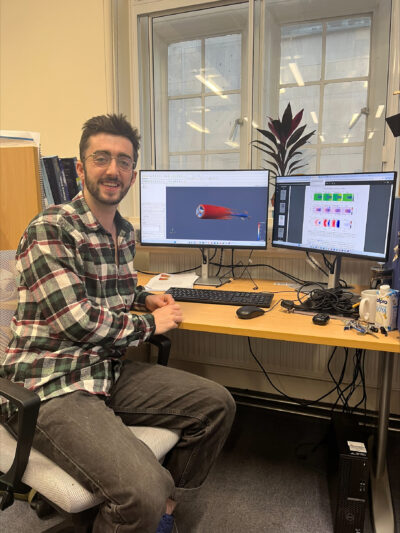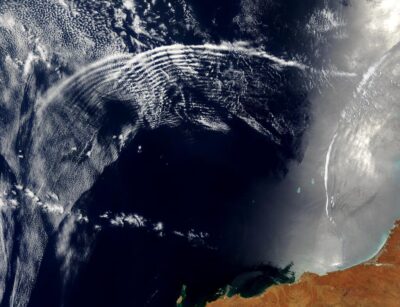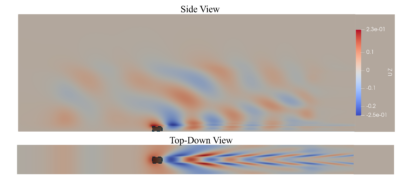
Tim Rafferty
Oxford Thatcher Scholar Tim Rafferty (2022, DPhil Engineering) explains how his work on the interaction between gravity waves and wind farms could drive the transition to renewable energy.
If you ask most people to predict where power generation in a wind farm is weakest, they’ll guess towards the back. It’s a logical assumption, if you suppose that downstream turbines sit in the wake of upstream ones. And, in fact, this concept of a cumulative wake deficit has for years been used as the key parameter in wind farm design.

Atmospheric gravity waves ripple in double, overlapping arcs of clouds over the Indian Ocean, revealed by NASA’s Moderate Resolution Imaging Spectrorad (MODIS).
But what if wind farms actually generated atmospheric gravity waves, a powerful and even destructive phenomenon with the capacity to upend all our received notions about windfarm design?
This ‘What if?’ was the starting point of my doctoral research as part of Oxford University’s wind and tidal energy group. Studying wind farms under realistic atmospheric conditions, we have now established that wind farms do indeed trigger atmospheric gravity waves by obstructing and displacing upwards the flow of wind, much as a hill does.
Once triggered, atmospheric gravity waves drastically alter the pressure field around a wind farm, resulting in a change in the performance of its turbines. Under gravity wave conditions, the turbines at the front perform up to ten times worse, while those at the back improve in performance. Given that offshore wind farms comprise hundreds of turbines, the percentage changes in power production as a result of gravity waves can be equivalent multiple of the turbines not even operating, representing millions of pounds in lost revenue.
It’s clear we need to understand atmospheric gravity waves in order to optimise the next generation of wind farms. To do so, my research asks three questions. First, do gravity waves impact turbine safety? Our original blade designs concentrated on maximum power production, so the additional loading from gravity waves on the blade, nacelle and tower remains unknown. Second, can we design wind farms to mitigate the impact of gravity waves, or even prevent their generation? Here, the distance between farms and the farm layout needs to be re-considered. Our preliminary investigations have indicated that farm power production can vary by 50% when situated downstream of a wave-triggering farm – hence farm separation is essential.

A vertical velocity plane from a simulation demonstrating the existence of gravity waves produced by a wind farm canopy (black box)
Finally, can the atmospheric conditions at different locations be used to optimise wind farm performance and thus boost the renewable energy output of the UK? Traditionally, the location of farms and their daily predicted power output was determined by wind speed. However, gravity wave effects and other atmospheric factors are often more impactful than the variation in wind speed, so factoring them into the design and location of new wind farms could revolutionise performance.
Last summer, the UK produced over 40% of its power from offshore wind. Just imagine if we could exponentially increase that number by designing wind farms which factor in the role of atmospheric gravity waves? In our fight against climate change, it could change everything.
This article was initially published in the 2024-25 edition of the Somerville College Report for Donors. Read the full issue here.
A longer version of this article can be found in the a lecture given by Tim at the Skills Hub event ‘From Farm to Table’ event, a full recording of which can be viewed here.
Images 1 and 4: Tim Rafferty speaking at a 2024 Skills Hub, Image 2: low-hanging fog shows what is not usually possible to see with the naked eye, wind wakes trailing behind turbines at Vattenfall’s Horns Rev wind farm off Denmark (Photo: Orsted), Image 3: The wave structure in these clouds over Mawson is caused by gravity waves in the Antarctic atmosphere Photo: Chris Wilson